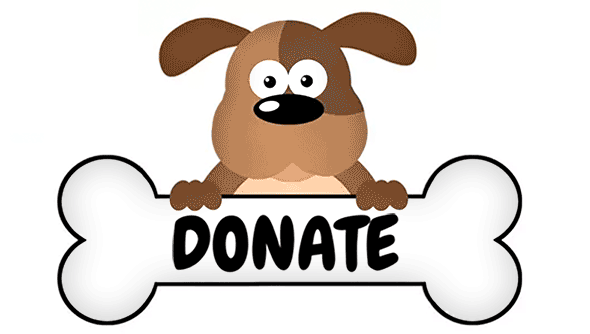Welcome Home, Doggy!
Before Your Dog Comes Home
- Make sure that everyone in your family agrees on the house rules, such as whether the dog will be allowed on the sofa and what rooms will be off-limits. You also need to be sure that everyone uses the same words for behaviors that you are requesting. For example, “DOWN” may mean lay down to you, and get off the bed to your partner.
- Choose a veterinarian who shares your philosophy of care.
- Get everything you need beforehand. Shopping online provides more options and cheaper prices, but make sure you don’t skimp on quality when buying the essentials. (See Essential Supplies below.)
- Set up the crate in a location near family activities, rather than in an isolated location.
- Dog proof your house. If you don’t want your dog getting into it, put it away. Install baby gates as needed.
- Read “10 Tips for Humans”!
- Attend one of our free monthly workshops for adopters, potential adopters, and fosters “Welcome Home, Pup!”!
Essential Supplies
- Crates: For small and toy dogs, get a sturdy plastic crate. For medium and large dogs, get a strong, epoxy-coated wire crate that folds up. For giant breeds, consider getting an exercise pen instead. Crates should generally be 1 ½ times the size of your dog without the tail.
- A six-foot leash, preferably leather or rope, with the suitable width for the weight of your dog. Do not get a retractable leash.
- Identification tags
- At least two heavy-duty, stainless steel bowls
- Both some of the food your dog is used to and high quality food with protein, not filler, so you can wean him off the other food and onto the better food
- Dog toys: relatively indestructible, solid rubber or nylon (can be stuffed with food), and sterilized bones; interactive toys that occupy and mentally stimulate your dog
- Dog bed – Orvis for Dogs and Kuranda have dog beds with guarantees against chewing.
- An enzymatic cleaner made for pet stains and odors – White vinegar is also good for removing pet odors, so that your dog doesn’t go back to the same place to pee or poop.
- Bags for picking up poop on walks
- Flea/tick/heartworm prevention: Discuss with your veterinarian.
Day One
- Try to pick up your dog at a time when he will have a day with you. However, don’t stay home for a week if that’s not your normal schedule. Your dog will have more trouble adjusting to your routine if he isn’t exposed to it.
- The car ride home may be traumatic for some dogs. Be prepared. Bring a few small treats to give him a good association with the car. However, he may be too stressed to eat.
- When you bring your dog home, let him first explore your yard. He will feel more relaxed and will have a chance to go to the bathroom. When he goes, reward him with praise and a treat! For the first few weeks, don’t just let him out. Go with him, so you can reassure him and reward him for going.
- If you have children, don’t let them crowd your dog, hug him, or squeal and run. Show them how to give the dog a treat with palm up and how to pet the dog on his chest or under his chin. They should wait for the dog to come to them, and have a treat ready when he does.
- If you have other dogs, let them meet the new dog in a neutral location on a very loose leash. Keep close watch on their body language, and expect competition over resources in the future.
- If you have cats, make them a sanctuary room before the dog comes and protect the litter box. Keep the dog on leash around the cat continuously and let the cat investigate his new housemate at his own pace. You might try rubbing the dog and the cat with a towel and putting the cat’s towel under the dog’s food bowl and vice-versa.
- On the first night, show your dog where you want him to sleep. Puppies definitely need to sleep in a crate, as should older dogs who are used to them. During the night, do not go to him if he barks. If you hear your dog fidgeting like he has to go to the bathroom or if you have a young puppy, take him to the bathroom at night without talking to him.
- You can give an adult dog a new name. It may even be a good idea if he has been mistreated and associates his name with punishment. Say your dog’s name often and when he looks at you, give him a treat.
Getting on a Schedule
- For the first week, mix the food you want to use with the food your dog was eating at the kennel, rescue, or breeder. Slowly, increase the amount of your food in the mixture until the dog is only eating the food you want him to eat.
- During the first few days, leave your dog alone for a period of time, so he can get used to being alone. Train your dog to a crate by giving him treats and feeding him in the crate with the door open. Gradually, get him used to the door closed. Have chew toys in the crate for him, but make sure they’re safe.
- Begin housetraining immediately. Assume the dog is not housetrained even if told otherwise.
- Expect accidents, even with a “housetrained” adult. In addition to learning your routine, an anxious dog may have loose bowel movements. Don’t punish your dog. Clean the accident with an enzymatic cleaner and stay calm.
- Your dog needs to be exercised regularly: about one hour walk, half hour play, and half hour mental exercise per day. If you don’t wear him out, he will wear you out.
- Stay on a schedule for sleeping, feeding, and walking, so your dog can learn your routine and be housetrained more easily.
- Take your dog to the veterinarian’s office the first week, and bring his medical records. You may want to visit the office with your dog first, more than once if you can, and give him treats there to reduce his fear of going to the vet’s.
Basic Training
- Start training with your dog immediately. Use only positive reinforcement training. You want your dog to trust you, have fun, and be a willing partner in training.
- Ask for the behavior you want from the start. For example, don’t feed your dog from the kitchen counter or table, so your dog doesn’t start “counter surfing” or begging.
- Ask your dog to sit before you put on his leash, feed him, or play with him. If your dog isn’t trained to walk nicely on a leash, use a no-pull harness to keep him from pulling you down the street.
- Praise and reward your dog IMMEDIATELY for good behavior. This will encourage him to do it again. Try to anticipate and prevent unwanted behavior. For example, attach a leash to your dog before he goes in the family room for the first time, so you can prevent him from getting on your favorite chair. Tap on the piece of carpet where you would prefer that he settle. As he is going down on the carpet piece, give it a name, like “go to place” and give him a treat right away to reward him.
- Don’t give your dog attention when he demands it. Call him over to you to give him attention after he has left you alone.
- Don’t punish your dog. This won’t help your relationship, and it won’t make you a leader in your dog’s eyes. What it might do is promote fearful aggression.
- Expect at least a two week “honeymoon”, during which your dog may be more timid and well-behaved than normal. Once he feels that your home is his, his confidence will build and you will see his personality assert itself. The honeymoon period is a good time to work on training and handling, though.
- Short list of skills to teach your dog: recognizing his name, sit, down, come, wait, leave it, give, walking nicely on a leash, greeting politely
- Take one of our classes!
Socialization
- Socialization is not the same as exposure. Bad experiences can have long-lasting effects. Don’t take your new dog to dog parks, where other dogs could bully him, or soccer games, where children could crowd around him.
- Have close friends or relatives who spend a lot of time at your house come over during the first few weeks one or two at a time, so your dog gets used to them. Have them drop a treat for your shy dog to encourage him. Give your boisterous dog a treat to reward a calm greeting.
- If your dog was mistreated in his last home, it could take him months to gain confidence. Go at his pace, and reward him generously for small steps. Forcing your dog beyond his comfort level is not a good idea.
Grooming
- Brush your dog, so he gets used to being handled. After a short grooming session, go for a walk or play a game. If your dog is scared, brush only down his back and on his shoulders. Give him treats as you are brushing.
- When you need to bathe your dog, put him on a mat in a dry tub, then add the water gradually after he is in the tub. This will be less scary for him. Use organic shampoo.
Books & Other Resources
Books
- Paws to Consider: Choosing the Right Dog for You and Your Family
by Brian Kilcommons and Sarah Wilson - Successful Dog Adoption
by Sue Sternberg - Choosing and Caring for a Shelter Dog: A Complete Guide to Help You Rescue and Rehome A Dog
by Bob Christiansen - Mutts – America’s Dogs: A Guide to Choosing, Loving, and Living With Our Most Popular Canine
by Brian Kilcommons and Michael Capuzzo - Adopt the Perfect Dog: A Practical Guide to Choosing and Training an Adult Dog
by Gwen Bailey




